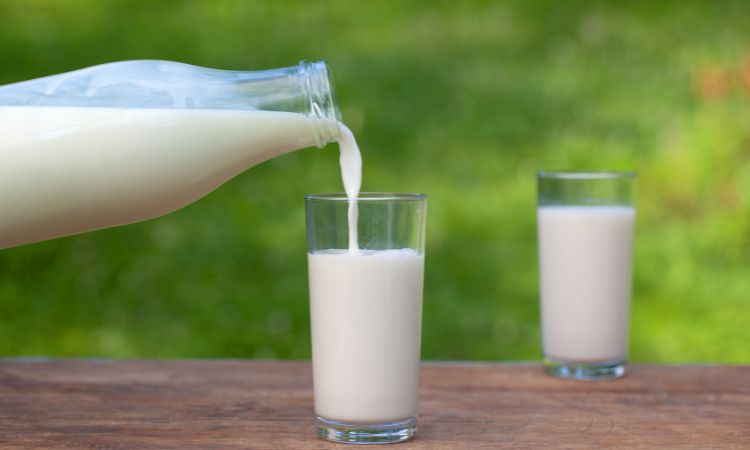
The global Fresh Milk Market Size is a vital segment of the dairy industry, driven by increasing consumption patterns, rising health awareness, and steady production growth. Fresh milk, valued for its nutritional benefits and versatility, plays a crucial role in daily diets worldwide. With global production reaching approximately 890.85 million tonnes in 2023 and anticipated to grow to 1073.90 million tonnes by 2032, the market demonstrates robust growth prospects.
Key Benefits of Fresh Milk
- Nutritional Value: Fresh milk is rich in essential nutrients such as calcium, protein, vitamins D and B12, and potassium, which contribute to bone health, muscle function, and overall well-being.
- Versatility: It serves as a base for numerous dairy products, including cheese, yogurt, and butter, making it integral to both food preparation and culinary diversity.
- Digestive Health: Fresh milk contains probiotics and prebiotics that support gut health and digestion.
Key Industry Developments
- Technological Advancements: Innovations in dairy farming and milk processing technologies have improved production efficiency and milk quality. Techniques such as high-pressure processing (HPP) and advanced filtration systems are gaining traction.
- Sustainability Initiatives: The industry is increasingly adopting sustainable practices, including eco-friendly packaging and energy-efficient production methods, to minimize environmental impact.
- Consumer Preferences: There is a growing demand for organic and locally sourced fresh milk as consumers become more health-conscious and environmentally aware.
Driving Factors
- Rising Health Consciousness: Increasing awareness of the health benefits associated with fresh milk is driving consumer demand.
- Population Growth: Expanding global populations, particularly in developing countries, are contributing to higher milk consumption.
- Economic Development: As economies grow, so does the disposable income of consumers, leading to increased spending on dairy products.
COVID-19 Impact
The COVID-19 pandemic significantly impacted the fresh milk market, with disruptions in supply chains and changes in consumer behavior. Initial lockdowns led to a decrease in demand from foodservice sectors, such as restaurants and cafes. However, the pandemic also saw an uptick in at-home consumption as people focused on health and nutrition. The market has largely recovered as restrictions eased, and production resumed normal levels.
Restraining Factors
- Price Volatility: Fluctuations in milk prices due to factors like feed costs and market conditions can affect both producers and consumers.
- Climate Change: Adverse weather conditions and climate change impact milk production by affecting dairy farm operations and milk yield.
- Health Concerns: Issues such as lactose intolerance and dairy allergies can limit market growth in certain demographics.
Market Segmentation
-
By Product Type:
- Whole Milk
- Skim Milk
- Low-Fat Milk
-
By Distribution Channel:
- Supermarkets/Hypermarkets
- Convenience Stores
- Online Retailers
- Others
-
By Region:
- North America
- Europe
- Asia-Pacific
- Latin America
- Middle East and Africa
Market Outlook
The fresh milk market is expected to experience steady growth, driven by increasing production and consumption rates. With advancements in dairy farming and processing technologies, along with rising health awareness, the market is poised for a positive trajectory. The forecast period of 2024-2032 will likely see further expansion, with global production expected to reach approximately 1073.90 million tonnes by 2032.
Trends
- Rise of Organic Milk: Consumers are increasingly opting for organic and hormone-free milk products, driving growth in this segment.
- Innovative Packaging: There is a growing trend towards eco-friendly and convenient packaging solutions, such as recyclable cartons and single-serve bottles.
- Increased Focus on Nutrition: Enhanced nutritional profiles and fortified milk products are gaining popularity.
Industry Segmentation
- Dairy Farming: Involves the production of milk from dairy cows, including large-scale and small-scale operations.
- Processing and Packaging: Includes the pasteurization, homogenization, and packaging of milk to ensure safety and extend shelf life.
- Distribution: Encompasses the logistics and supply chain aspects of delivering fresh milk to consumers.
Regional Analysis
- North America: The U.S. and Canada are significant contributors to the fresh milk market, with advanced dairy farming practices and high consumption rates.
- Europe: Countries like Germany, France, and the UK have well-established dairy industries and a high demand for fresh milk.
- Asia-Pacific: Rapid urbanization and rising incomes in countries like China and India are driving market growth.
- Latin America: Brazil and Argentina are major producers and consumers of fresh milk in this region.
- Middle East and Africa: The market is expanding due to increasing demand and investment in dairy farming infrastructure.
Top Impacting Factors
- Consumer Preferences: Shifts towards healthier and organic products influence market trends.
- Production Costs: Costs related to feed, labor, and technology impact pricing and profitability.
- Regulatory Standards: Compliance with health and safety regulations affects production and distribution practices.
Major Key Players
- Nestle SA
- China Mengniu Dairy Company Limited
- Arla Foods Group
- Cooperativa Central Dos Produtores Rurais De Minas Gerais Ltda. (Itambe)
- Gujarat Cooperative Milk Marketing Federation Ltd. (Amul)
- DMK Deutsches Milchkontor GmbH
- Dairy Farmers of America, Inc.
Opportunities
- Expanding Market: Growth in emerging markets presents opportunities for increased sales and market penetration.
- Product Innovation: Developing new products and flavors can attract diverse consumer segments.
- Sustainability: Investing in sustainable practices and eco-friendly packaging can enhance brand reputation and appeal.
Challenges
- Price Fluctuations: Managing the volatility of milk prices poses challenges for both producers and consumers.
- Environmental Impact: Addressing the environmental footprint of dairy farming requires ongoing efforts and investments.
- Health Issues: Catering to consumers with dietary restrictions and health concerns involves product diversification and innovation.
Scope
The fresh milk market encompasses the entire supply chain from dairy farming to consumer consumption. It includes various product types, distribution channels, and regional dynamics. The market’s future growth will be driven by advancements in technology, changing consumer preferences, and global economic trends.
Read More Reports:
Global Cocoa Market
Global Database Management System (DBMS) Market
Global Electronic Equipment Market
Global Tissue Paper Market
Global Convenience Food Market
United Kingdom Energy Bar Market